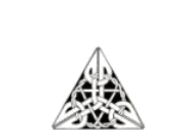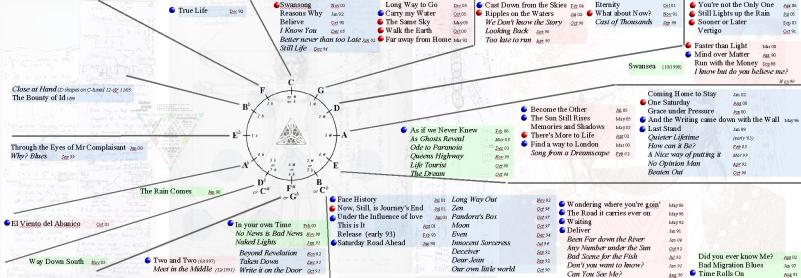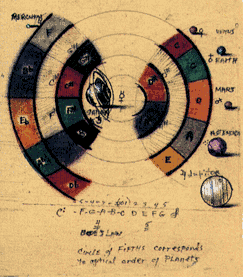

"stunning and thought-provoking... a real artist in a sea of imitators." - `Eden Dust Records Read more Quotes
Choosing from a large and dynamic original repertoire James rarely, if ever, plays the same set twice. Although his repertoire has since outgrown it, in an effort to bring all his songs into a single evolving set-list he created what he called a 'Song Map'. Based conveniently around the Circle of Fifths, which originates at least as far back as Plato's The Myth of Er. The idea was that when improvising between songs, James need only glance at the map (where all songs are grouped together by key) and choose the appropriate song for that moment while he continued to play and then segue into the chosen song. The Song Map is shown here as a curio.
Click to hear James' music

James created the first version in late 2006 after many years of considering how to present his songs in some kind of key order. This version became covered in written notes during extensive use and the second printed version is shown above, with songs not only placed in areas corresponding to their key, but also to their general 'feel'. Red areas are more up-tempo, 'brisk' songs, the Blue areas are more relaxed, while the Green areas cover those in a minor key. Tracks are in chronological order and those in italics have either been forgotten or still being memorised. For quick-reference during live performance songs that are often requested are tagged with red discs, and the blue discs indicate songs James also found went down well with audiences. Other tracks had yet to acquire a recognisable pattern.
Blog from 24 January 2007 - Musings on Music, Astrology, Myth and Magic
In 1992 I bought one of those books that take years to read: Music, Mysticism and Magic: A Sourcebook, compiled by Joscelyn Godwin. I was fascinated to read that Plato's The Myth of Er linked the movement of the Planets to Music by comparing their relative orbital speeds to the frequency of sound vibration. From the literature it seemed that Socrates was attempting to relate the 12 notes in the diatonic scale to the 12 houses of Astrology, which certainly caused me to stop, stare and blink. I was sufficiently inspired to use the Circle of Fifths for my new set-list as well as being satisfied that it was also perfect on a practical level for the purpose of presenting all my songs together in their respective keys.

So here I shall examine the matter as a whole in a little more depth and see if it would be worth investigating each song in more detail. It may be that I find I would need considerably more expertise in Astrology to do so, or perhaps this exercise would be a vehicle for delving into the subject. The only condition of pursuing this mode of enquiry would be that it provide insight into the song.
How would the key of the song provide any insight? That a twelfth of the human population is of one Astrological sign or other does not mean that they are all the same personality. Other intrinsic characteristics must be sought. I have already determined that some songs relate to each other by sharing certain motifs. Perhaps I should look at the dates the songs were written and seeing how they relate to other songs which share these motifs? The motifs themselves could indicate ruling planetary influences directly, but this would be backward analysis and could not be conclusive without firm evidence. Comparing these motifs with a song's Astrological chart may be more helpful, however, but this would not require any consideration of Musicality.
The date a song is written would only provide insight in standard Astrological terms, and would not relate at all to the Circle of Fifths unless there were some element of musicality involved in its analysis.
Perhaps I could look at the chords that the songs include to establish some kind of Planetary interaction? But this method would be limited in a number of ways, including my chance habits of using some chords more than others (especially in the early period of my song-writing where my lack of technical skill restricted the chords I could actually play), and ultimately which chords are in that diatonic key anyway. There are 7 base chords in a diatonic key, and if a song is transposed to another key, does its entire astrological character change also? Clearly not very much.
I could consider how the additional notes added to a chord affect its place in the scheme of things. Up to 9 different notes can be added to a chord in addition to the 3 required to make a chord in the first place. The total of 12 notes being the same number as the 12 astrological houses may be of superficial significance, but if we are so inclined how are we to determine, for example, the relation between intervals of the scale in Astrological terms, except by direct reference to the Planetary parallels described in The Myth of Er? If a song is transposed by one semitone, it does not change significantly in character so matters can not be as simple as this.
Incidentally, it should be noted that the modes were originally based upon a fixed pitch making such modern flexibility almost impossible. Transposition of a song would therefore probably have caused rioting in the streets of ancient Athens: you'd probably have been lynched for playing freeform jazz. I gather that the Indian Ragas are also based upon fixed key centres for their relative scales, but while I know little of Classical Indian Music, I do know that Indian, or Vedic Astrology is even more complicated than the western tradition. So let's not go there.
Therefore I must conclude that the reason why there has been no elaboration on this them previously is that it is a blind alley. The best way to look at the life of a song is at the significant dates of its initial inspiration, date of completion, date of recording and so forth. I know little of how to do so, but I believe there is a way to examine the relationship between the charts of two entities. In this case the charts of the composer and the song might perhaps be compared to shed light upon the nature of the song.
If I ever make the attempt to look deeper into this, I should think it would be on a one-off experimental basis. Should the exercise prove illuminating, I'd probably follow the path thus lit and go where'er it might show...
James
home | gigs | music | images | more | promo | contact
© 2018 James Hollingsworth. All rights reserved.